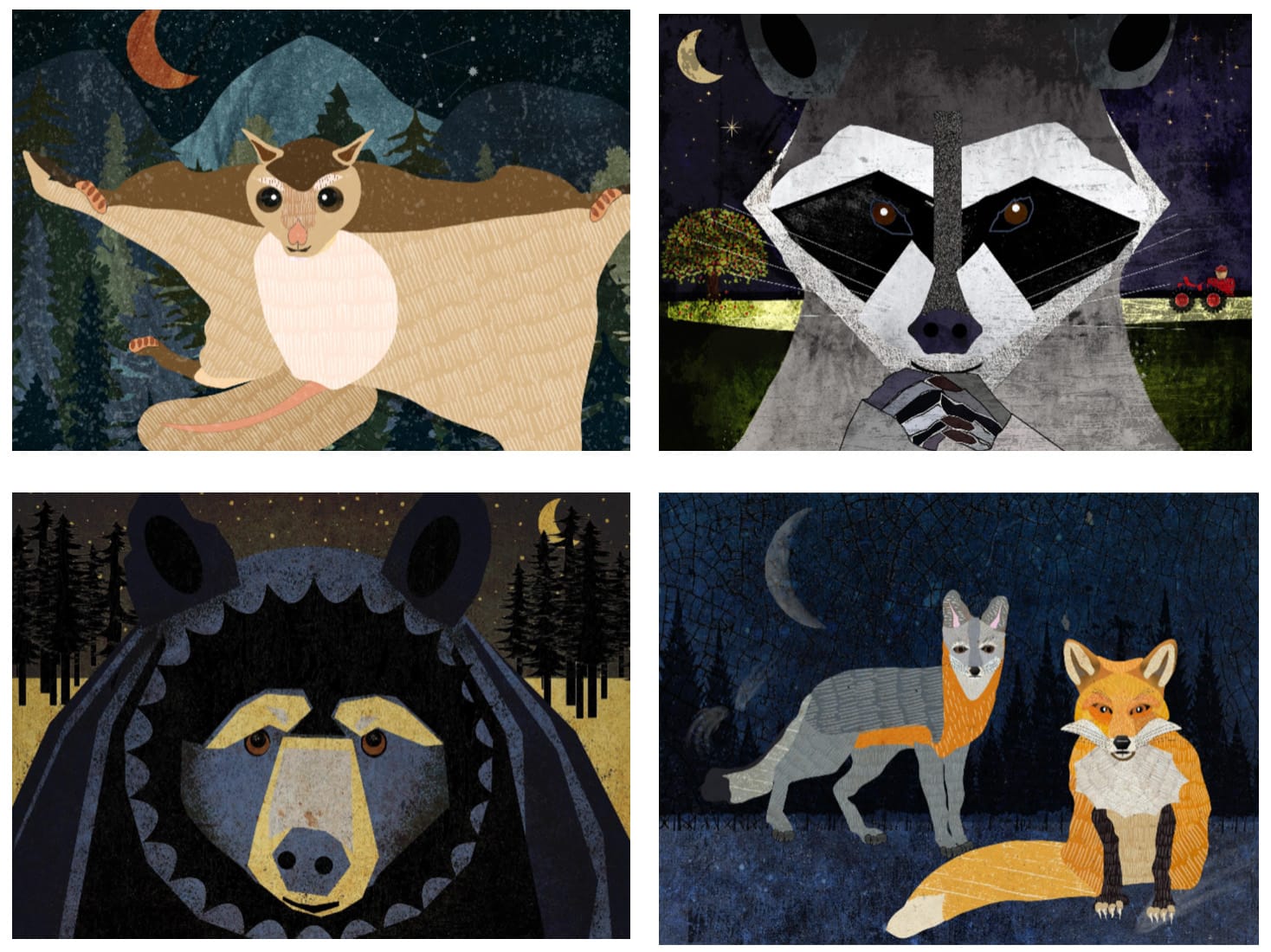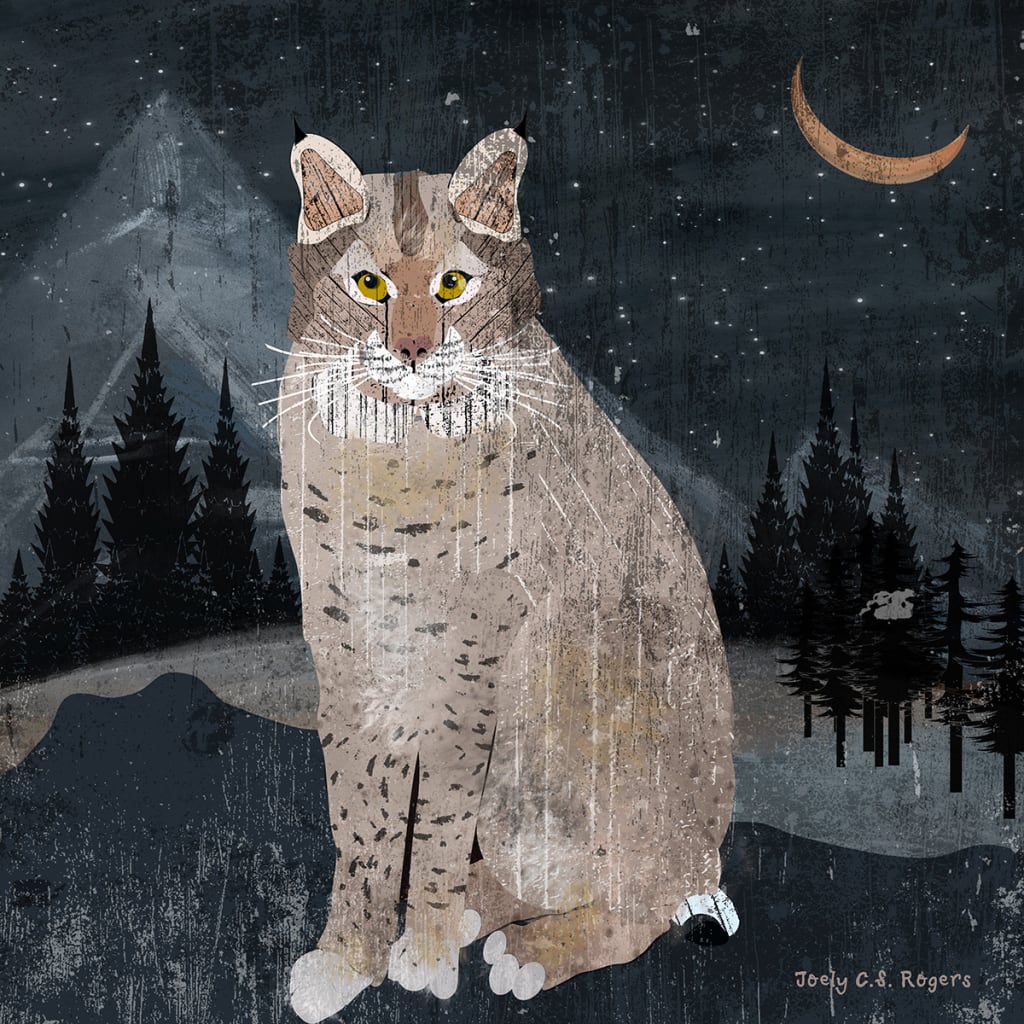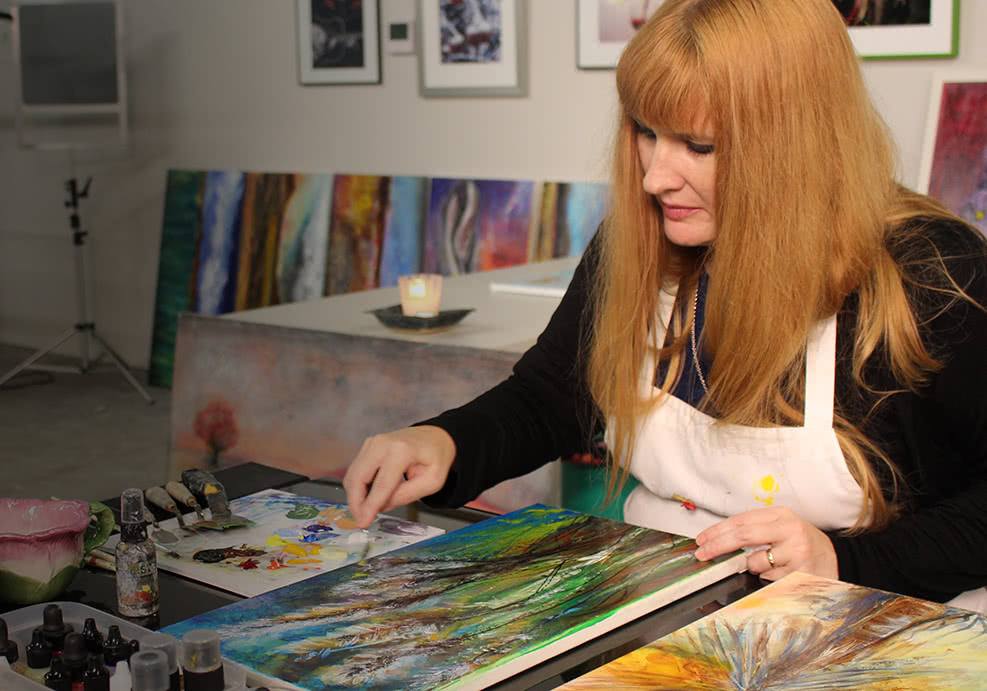How to Pursue, Secure, and Prepare for an Art Show
Case Study: "Night Creatures of Rainbow Mountain"
What do Bobcats, Flying Squirrels, and Eastern Screech Owls have in common? They all party in my backyard at night.
Of course, I fully approve of these nocturnal revelers. We set up game cameras around our home on Rainbow Mountain in Montreat, North Carolina, just to capture images of the various animals roaming our property from dusk to dawn. From these photographs, I created “Night Creatures of Rainbow Mountain” — a series of 30 digital illustrations depicting 16 wild animals within their natural environment, along with a corresponding portrait rendered in greater detail.
The Why: My goals were to raise awareness about the animals living in Montreat, educate the public about the key roles these animals play in a cove-forest ecosystem, and inspire a sense of wonder at the beauty and diversity of our Appalachian wildlife.
The What: I wanted to accomplish these goals through an art show where some of the proceeds would benefit Appalachian Wildlife Refuge. As a professional artist, I planned to benefit financially as well, and crunched numbers on how best to make a profit while making my work accessible.
The Call: When Black Mountain Center for the Arts issued a call for submissions, I’d already laid some groundwork. I’d attended their shows, taken a few classes, and participated in two group exhibits. With a relationship built, I felt confident approaching the gallery with my “Night Creatures of Rainbow Mountain” work, knowing it would strike a chord with our nature-conscious community. And so I submitted my artist statement, my artist biography, and a PDF discussing “The Why” and “The What.” The PDF included the images, their sizes, and how I would frame them. I did not suggest pricing because I wanted to discuss that with the gallery if my work was accepted. Fortunately, the gallery’s board of directors chose my work. Feeling grateful and excited, I designed the exhibit poster myself in Adobe Express, printing it via Vistaprint.
If you’re in my neighborhood this November, check out the exhibit. I hear there will be animal-themed cupcakes at the show!
“Night Creatures of Rainbow Mountain” Exhibit
Black Mountain Center for the Arts
November 3 - November 26, 2023
What’s Ahead in This Post:
- Tips for Approaching a Gallery
- How to Memorably Tell Your Art Series Story
- Maximize Your Art’s Value with Quality Paper and Frames
- Gift Shop Prints: Choosing Which Artworks to Sell
- Digital Illustration at a Glance
Tips for Approaching a Gallery
Do your homework. Before you approach any gallery, you should research which ones are a good fit for your work. Don’t be afraid to look outside your immediate “comfort zone.”
Go to gallery events. There’s no better way to become familiar with a gallery’s audience than attending various events. If the gallery is too far away, peruse their social media to see recent work and gauge response from followers.
Beef up your social media and website. Keep your website as up to date as possible, with titles, measurements, the medium used, and descriptions. Instagram and Facebook are great ways to create an even more "current" vibe; you can share time-lapses of your work in progress or short videos where you talk about what inspired a particular piece. People love a good story — and seeing the artist behind the art.
Make a shareable portfolio. Rather than sending a gallery director to your website and expecting them to follow through, include a PDF directly in your email. The PDF should comprise the proposed works you’d like to show, any previous sales, your artist statement, and your artist biography. Keep your email brief, friendly, and professional.
How to Memorably Tell Your Art Series Story
If you’re an artist, you know how passion influences your work. For me, “Night Creatures” was an ideal assignment: It combined my professional training in natural science illustration, my graduate academic training in education and storytelling, and my overall affection for beings that crawl, climb, hop, and fly.
Organizing the Critters: My Cast of Characters
When you have multiple pieces in a series, the first step is to organize the work. I asked myself, “How do I share this ‘wild’ story in a systemized, yet interesting, way?” Then I came up with groupings and titles that hint at each animal’s role and personality. For example, the Luna Moth in the featured image (top of article) begged for the title “Night Dreamers.” A large, brightly colored insect found in broadleaf forests, Luna Moths are named after Luna, the Roman moon goddess. Most human interactions with these elusive winged creatures occur when artificial light sources attract them.
Meet the Stalkers, Singers, Flyers, and Hustlers
Let’s meet a few more of my backyard buddies…

Clockwise from top left:
~ “Night Flyers” (aka, Southern Flying Squirrels), cover up to 150 feet per glide and disperse seeds, nuts, and fungi as they forage year-round.
~ “Night Hustlers” (aka, American Raccoons) are intelligent scavengers. Their extremely sensitive front paws have specialized hairs that identify objects by touch.
~ “Night Tricksters” comprise two types of foxes. The American Red Fox is a playful creature who can run up to 30 mph while evading predators. Gray Foxes are a bit smaller and have retractable claws that allow them to climb trees, making them more adaptable to certain ecosystems.
~ Iconic American Black Bears are our “Night Walkers.” Omnivores who will walk up to 20 hours during their hyperphagia feeding phase, Black Bears play an important role in the ecosystem as seed dispersal agents.
All four of the above prints measure 16”W x 12”H, with an outside frame size of 22”W x 18”H.
Maximize Your Art’s Value with Quality Paper and Frames
Do you really need to use the highest quality materials? In my experience, yes. You’ve worked hard to create a one-of-a-kind work of art, spending untold hours and diving deep into your unique imagination. Why would you showcase your masterpiece in anything less than the very best light? Answer: You wouldn’t, and you shouldn’t!
Taking my own advice to heart, I printed all 30 “Night Creatures of Rainbow Mountain” exhibit images with archival ink on Epson Hot Press Natural Paper — an acid-free 100% cotton rag content with a natural smooth finish. I’ve hand-signed, dated, and framed the images using the components listed below.
- Wood Profile 532 in Satin Pewter ~ Neutral frames can enhance your art, rather than distract from it by looking “amateurish.” Black, white, and gray are great choices.
- Crescent Select 4Ply Window Mat Boards ~ As the “frame within the frame,” matting draws in the viewer’s eye and helps create the mood and substance of your art. I created a double mat: the top mat is white while the bottom has a colored border.
- Acid Free 3/16" Foam Board ~ Although 1/8” is also an option, a 3/16” backing board is less likely to warp, providing additional stability for large picture frames.
- UV/Non-Glare Acrylic ~ For larger works, UV/Non-Glare is a nice lightweight option and less prone to breaking than glass.
- Spacer - Black FS1 ~ Picture frame spacers do just as their name suggests — they add space within the frame, which prevents frame glazing from contacting your art and potentially causing damage.
- Wood Frame Hanging Kit ~ This kit includes adhesive bumpers to protect your frame and wall.
Below we see my “Bobcat” image both unframed and framed. As “Night Stalkers,” Bobcats (or wildcats) are territorial and typically solitary when it’s not breeding season. They’re carnivores and help maintain reasonable population numbers of animals like rodents and rabbits.

“Bobcat” // Print Size 14”W x 14”H // Outside Frame Size 20”W x 20”H
Gift Shop Prints: Choosing Which Artworks to Sell
During an exhibition, many art shows offer matted prints in smaller sizes presented in clear bags for sale in their gift shops. After conducting an informal Facebook survey, I chose 10 images with the highest votes. I matted these prints using cheaper, non-archival materials for cost-conscious individuals.
Now let’s look at the medium that inspired all this work!
Digital Illustration at a Glance
Digital illustration uses computer technology to craft artworks from scratch — as opposed to scanned art or digital photos. Rather than using pencil, ink, or paint on paper or canvas, the artist uses a variety of tools like a mouse, stylus, or other digital devices.
Mathematician and computer scientist Frieder Nake was one of the world’s first digital artists. He used a finely tuned drawing machine to create over 300 “aesthetic drawings” in the 1960s. Another early adopter of this new art form was Susan Kare, best known for creating pixel art and icons for maiden Apple Macintosh computers in the early 1980s.
Now that technology has caught up with our collective imagination, digital art is pervasive across the globe. Today’s top digital artists include Mike Winkelmann, aka “Beeple,” famous for selling a portion of his works for $98 million. Check out our article on Digital Art to see artworks of past and present digital artists.
Are You Inspired?
I hope my “Night Creatures of Rainbow Mountain” case study equips you with the steps and the inspiration to pursue, secure, and prepare your own art show — whether it’s digital art or another medium. If I can do this, you can too! Share your story with us when you do.
Bonus Tips and Further Reading:
5 Tips for a Successful Gallery Show
Tips for Framing Art for a Gallery Show
Writing an Artist Biography vs. Statement: Why You Need Both
Last updated September 28, 2023
Written by Joely Rogers
 Joely C. Rogers is an artist/illustrator and writer living in the mountains of western North Carolina. She has professional training in both natural science illustration and the culinary arts, as well as graduate academic training in education, sociolinguistics, and folklore/storytelling. She is a Blue Ridge Naturalist candidate with the North Carolina Arboretum and a member of the Guild of Natural Science Illustrators.
Joely C. Rogers is an artist/illustrator and writer living in the mountains of western North Carolina. She has professional training in both natural science illustration and the culinary arts, as well as graduate academic training in education, sociolinguistics, and folklore/storytelling. She is a Blue Ridge Naturalist candidate with the North Carolina Arboretum and a member of the Guild of Natural Science Illustrators.